55.24% of web pages on the Internet have zero backlinks, and 29.79% have fewer than 3 backlinks.
This creates an excellent ground for expanding your link-building efforts. Not everyone is doing it, and it’s a great way to differentiate yourself. You’ll gain referral traffic, better rankings, and more visibility in search engines.
Backlink outreach is an excellent start to link building. It’s one of the most popular ways of getting quality backlinks—mainly because it works best!
Given this landscape, the following sections will explain why backlink outreach is essential for your SEO strategy, how to implement it effectively, and the best practices for making your outreach efforts stand out.
Let’s jump right in!
What is Backlink Outreach?

Backlink outreach is a strategy used in SEO. Marketers contact other websites to secure links back to their sites, aiming to improve their search engine rankings and online visibility.
There are several techniques you can use.
Types of Backlink Outreach
Types of link building outreach vary, and each creates a unique opportunity for a backlink.
Broken link building
Broken link building? Here’s the scoop. First, pick a tool. Ahrefs or Semrush work great. Think about which sites you want links from. They should match your niche.
Next step: hunt for broken links. Use your tool to find links that go nowhere, like 404 pages. Not every broken link will work for you. Find the ones that fit your content.
Got a match? Awesome. Now, make sure your content is ready to shine in that spot. It needs to be useful and on-topic.
It’s time to reach out. Contact the site owner or the person in charge. Keep it friendly but straight to the point. Tell them about the broken link. Offer your content as the fix. Don’t forget to give them the exact spot of the dead link on their site.
And that’s it. You’re doing them a favor, and you get a backlink. Win-win.
A-B-C link exchanges
Swapping links, where you link to a site, and they link back, is a classic move for getting backlinks. But, heads up, Google’s not a big fan of this back-and-forth game.
Here’s a workaround: bring a third site into the mix. You set up or find another site, then use it to swap links. This way, you’re not directly trading links with your main site.
Take Jotform’s playbook, for example. They use noupe.com to swap links without directly linking back from their own website. Smart, right? It keeps their site on Google’s good side.
To find link building partners, visit Slack, Facebook, and LinkedIn groups.
Relationship-based link building
As of recently, relationship-based link building is all the rage. It usually consists of communities of bloggers and editors who can exchange links easily through software like Slack. There are plenty of such communities which are open to new members.
All you need is links from even one website you can offer other editors. If the metrics are OK, they will be happy to give you a backlink. You can join them almost instantly and start exchanging backlinks.
Unlinked mentions
To harness unlinked mentions, start with Ahrefs or Semrush. These tools help you find where your brand pops up online.
Check each mention. Does it link to you?
Look for the rel attribute, too. Your targets are mentions without links or with nofollow links.
Next step: reach out. Explain the mention and suggest adding a link. Note that it might help their readers. Offer something in return. Maybe exclusive content, a link on another site, or a discount.
No reply? Follow up. Emails get missed.
Unlinked mentions can be super effective. You can sometimes get free links that way. Most of the time, however, you need to offer something in return.
Skyscraper technique
The skyscraper technique consists of the following steps:
#1 Identify an article that has attracted numerous backlinks.

#2 Create a superior version of it.
#3 Convince those who linked to the original piece to link to your content instead.

You can speed up this process by directly contacting the sites that have linked to your competitor’s article and suggesting they link to your improved version.
Your content might stand out due to its use of fresher, more accurate data, the inclusion of results from a recent survey, or the incorporation of insights from recognized industry experts.
Aim to offer something that sets your article apart from the original.
Guest posts
Guest posting remains a top choice for link builders. Even though it’s been battered and bruised over the years, it still works wonders.
Many start with a Google search: “keyword” + “write for us.” This method brings many links, but they’re often not the best quality. Why? Because it’s a common strategy among marketers. These sites have too many outbound links, reducing the value of each link.
A better strategy? Look elsewhere.
Use Ahrefs to find sites with many authors. Chances are, they accept guest posts.

Dive into social media groups to see where others are posting. If they can do it, why not you?

These are the spots you want to target. Focus on genuine business blogs, not the ones that publish just about anything.
Connectively (HARO) and similar
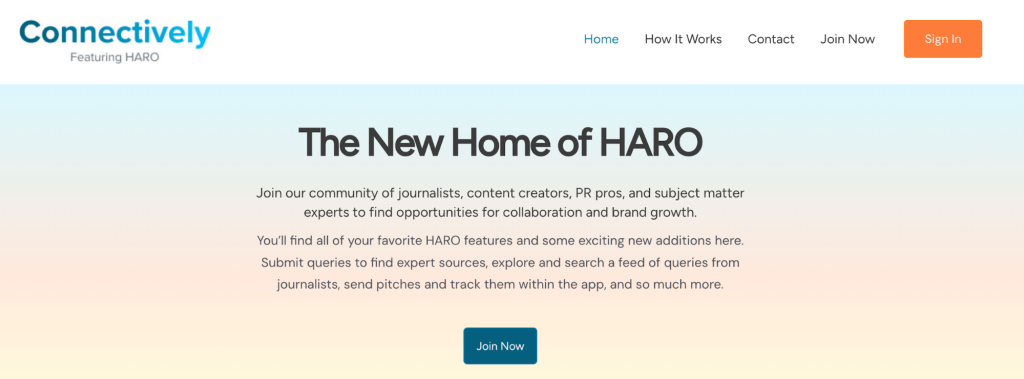
Connectively and similar platforms offer a unique way to build backlinks by responding to journalist queries. These platforms help you provide expert quotes to writers. If a writer likes your input, they often link back to your website.
To make the most of these opportunities, respond quickly to queries. Your expertise has to be relevant to the query as well. Be informative yet concise.

However, this outreach strategy has its limitations. Typically, you can only link to your homepage. It’s also hit-or-miss, requiring numerous pitches to see significant results. The conversion rate for these efforts is usually less than 10%. On top of that, these platforms are quite crowded.
Paid platforms exist for those looking for less competition. They’re not as saturated, offering better chances for success. The downside? You need to pay a monthly membership. Platforms like Qwoted, Terkel, and SourceBottle operate on this model. They send you journalist queries, to which you can respond, potentially earning a valuable backlink.
Through these apps, you can get links on the following authoritative sites:
- Forbes.com
- GOBankingrates.com
- MSN.com
- finance.yahoo.com
- and more!
Digital PR
Digital PR is all about getting your brand noticed online and snagging those valuable backlinks. Here’s the play-by-play:
Start with digging up some interesting data. Government sites, Google Trends, and places like Statista are gold mines. Found something excellent? Great. Now, make sense of it. What’s the story here? Your job is to find it and make it interesting.
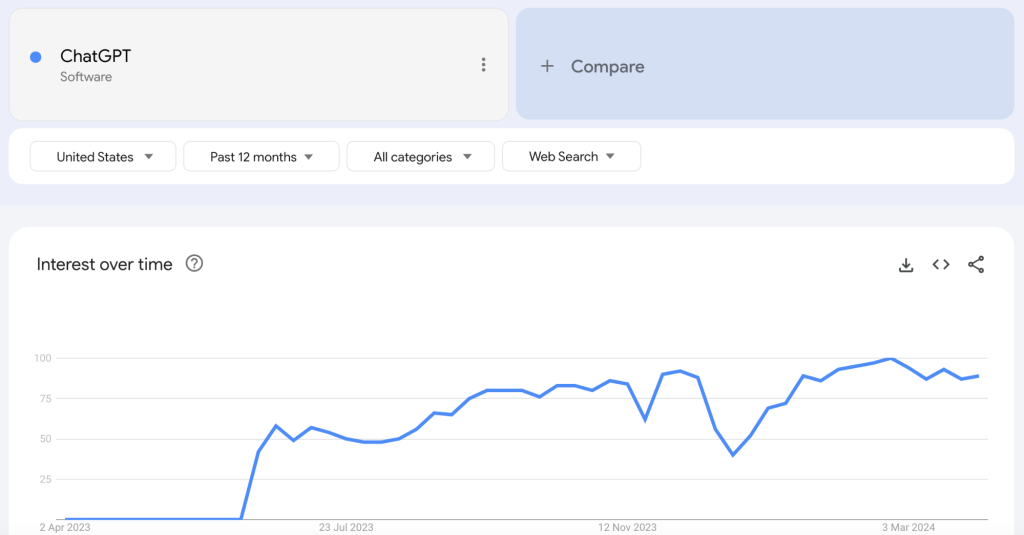
Next, create something shareable. It could be a report, an infographic, or a blog post. The trick is to keep it engaging and easy to understand.
Now, think about who would want to read this. You’re looking for journalists and bloggers who cover your topic. Tools like Woodpecker are perfect for reaching out to them. It lets you send personalized emails to a bunch of people without breaking a sweat.
Here’s where you pitch your story. Keep your email short. Tell them what you found and why their readers will care. Be direct but friendly.
For example, say you found a trend in how cities are using green energy. You put together an infographic that lays out the data in a fun way. Then, you find relevant journalists using tools like Pitchbox. You use Woodpecker to send it to journalists who write about green tech and urban planning. In short, your email says, “Hey, saw you’re into green cities. Check out this interesting info on how they’re leading the charge in green energy. Thought your readers might dig it.”
That’s digital PR. You share good stuff, and you get your name out there. Plus, those backlinks start rolling in.
How to Conduct Backlink Outreach
Outreach is one of those link building tactics that demands a mix of finesse, research, and persistence. It’s not just about shooting off emails and hoping for the best. You need a strategy, a clear message, and a bit of charm to cut through the noise.
Here are some best practices when it comes to link building outreach.
Discover the right websites
To identify the best websites for backlinks, start by examining the backlink profiles of your competitors. Tools like Ahrefs are invaluable for uncovering potential relevant and authoritative websites.
Pay close attention to key metrics: Check if the ratio of all the referring domains to linking domains is at least 1:1. Evaluate the organic traffic and Domain Rating (DR), and, for specific link insertions, look at blog post-level traffic and links.

The cache date of an article is also super important if you’re considering a link insert, as it indicates the content’s freshness and how often Google visits it. To check it, put cache: before the URL, like so: cache:example.com/blog/.

Additionally, assess the general traffic trend of a site—it should be on an upward trajectory. Above all, make sure you’re looking only at relevant websites. To ascertain this, look at what the website is ranking for. If the keywords are related to your niche, this is your best bet.
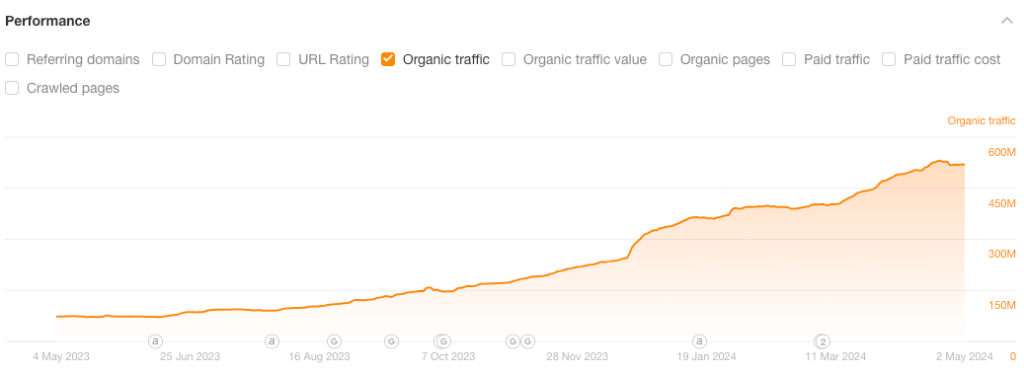
These steps will guide you to the most beneficial websites for your backlink strategy.
However, you’ve got to know who you’re going to target.
Find the correct prospects
To effectively find the right prospects for your link building outreach, target individuals who are most likely to engage with your request.
Focus on website owners, SEO managers, marketing managers, and link building specialists. They’re the ones to contact. LinkedIn is an excellent resource for identifying these professionals within your target organizations.
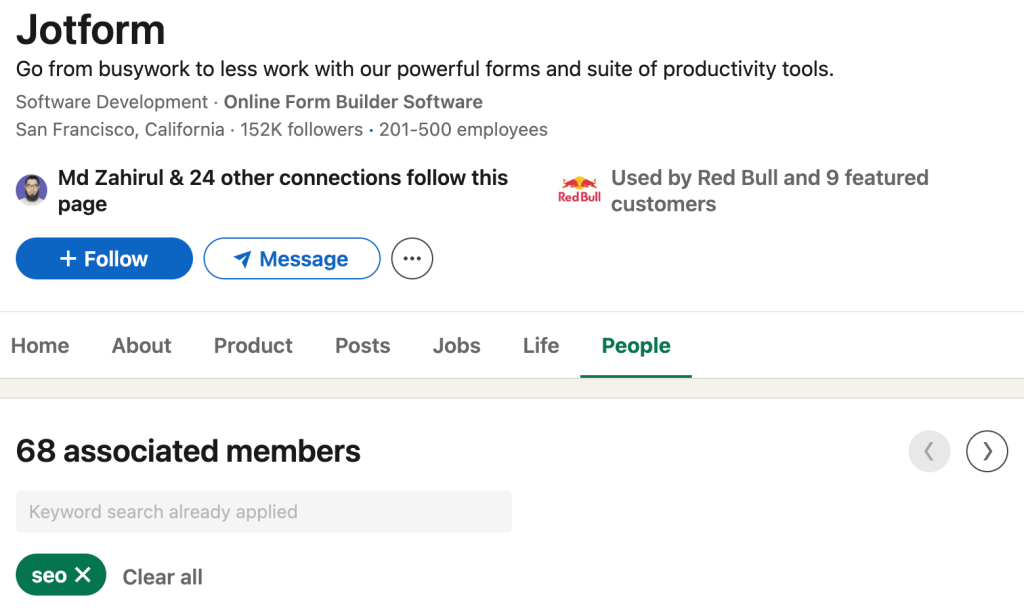
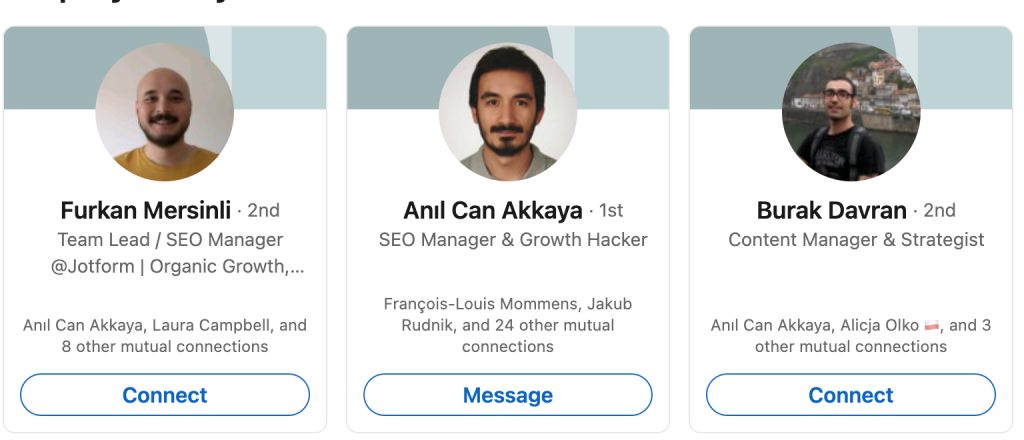
Once you’ve pinpointed the right contacts, use tools like Hunter.io or Voila Norbert to quickly gather their email addresses. This way, you’re reaching out to the most relevant individuals. The result? Better reply rates and more backlinks!
Personalize
Personalize every aspect of your outreach. Use their name, customize the subject line, and reference their work or interests. This technique demonstrates genuine interest, setting you apart from mass email campaigns.
Example:
Subject: Loved Your Insights on [Topic], [Name]!
Body:
Hi [Name],
I recently came across your article on [Topic], and I was really impressed by your take on [Specific Point]. It got me thinking about how we could collaborate to add even more value to your readers.
I’ve developed a piece on [Related Topic] that dives deeper into [Specific Aspect] you mentioned. Given your audience’s interest in [Topic], I believe they’d find this piece particularly enlightening.
Would you be open to discussing a potential collaboration or link exchange? I’m looking forward to your thoughts!
Best,
[Your Name]
Woodpecker lets you personalize every aspect of your link building message.
Use a work email address

In addition to personalization, use a work email address to significantly improve the credibility of your communication.
Emails from generic providers like @gmail.com or @outlook.com can often be perceived as less professional or even spammy. This perception might lead to your message being ignored or outright rejected, regardless of its content.
On the other hand, a work email address that includes your company’s domain not only boosts the trustworthiness of your email but also demonstrates professionalism and legitimacy. This small detail can make a big difference in whether your outreach efforts are successful.
Use your own templates
There are tons of templates all over the internet.
Creating your own outreach templates is super important. It helps you stand out. Marketing and SEO professionals often recognize and disregard emails that use overused templates. Design unique templates, and you demonstrate effort and originality.
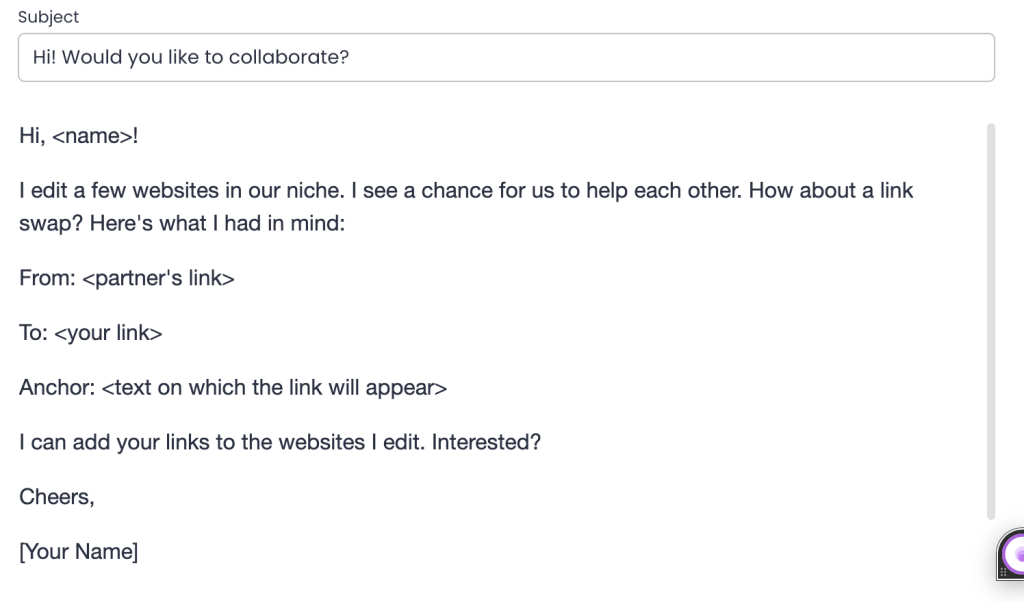
In addition to crafting original content, remember to include your company signature and links to your social media profiles, such as Twitter and LinkedIn. This lends credibility to your message and encourages recipients to engage with your brand on multiple platforms.
Your email should not just aim for a backlink – it should strive to foster a genuine connection.
Be careful with mass email tools
When using mass email tools for large-scale outreach, proceed with caution. These tools can send thousands of emails quickly, but they come with their own set of challenges.
First, make sure your inbox is properly warmed up. Without this, your delivery rates could plummet, leading to your emails landing in spam folders.
Use Woodpecker to warm up your inbox.
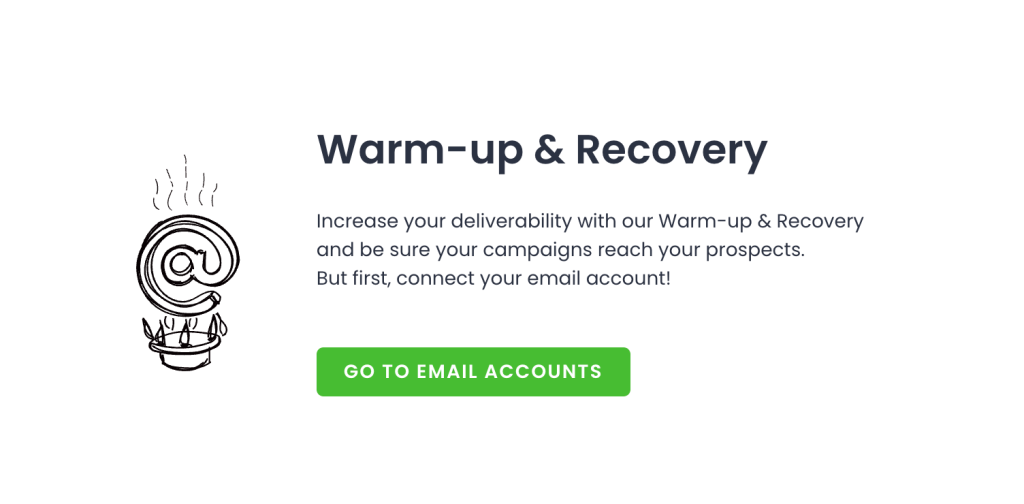
Additionally, mass email tools distribute the same message to a vast audience; any mistake in your email is shared with everyone. This can harm your brand’s reputation and the effectiveness of your link building campaign.
Always double-check your content and settings to minimize errors and maximize impact.
You will be sending tons of emails so you’ve got to be sure your inbox is proper. This brings us to the next point.
Send A LOT of emails
Outreach truly is a numbers game. Your reply rates can vary widely, from 1% to 20%, based on how you approach it.
To hit your targets, you’ll need to send a significant number of emails. Opting for a sniper’s approach, with high personalization, can boost your reply rates. That means fewer emails.
On the other hand, a shotgun approach, with less focus on targeting and personalization, tends to yield lower reply rates but you can send more emails that way.

Your approach will depend on your goals, market situation, and industry. In any case, send as many emails as you can.
Example:
If you’re targeting tech blogs for guest posting:
- Sniper approach: Research each blog, mention a recent article you liked, and suggest a topic that fills a gap in their content. Send 50 tailored emails, aiming for a 15% conversion rate.
- Shotgun approach: Draft a general guest post offer highlighting your expertise. Blast it to 200 tech blog contacts with a broader message, aiming for a 5% conversion rate.
Both link building strategies have their place. Choose based on your resources and goals.
Follow up, but don’t spam
Following up is pivotal in outreach, but you have to remember to avoid crossing into spam territory. Generally, one to two follow-ups are sufficient. If there’s no response after two attempts, likely, they’re not interested.

To streamline your process, schedule these follow-ups in advance using Google’s email schedule function. Tools like Woodpecker can automate this task. Either way, you can remain consistent without manually tracking each follow-up.
Be direct and quick

Keep your outreach emails direct and concise. State your offer and what you need within the first two sentences. The rest is just supporting information. Aim for a word count of 50-80 words to effectively convey your message.
This way, you respect the recipient’s time and increase the likelihood of a response by getting straight to the point.
Show a clear value proposition
You don’t want to beg for a link – you have to to present a clear value proposition. Instead of merely asking for a link, highlight what you can offer in return.
This could be a reciprocal link from another website, financial compensation, or a high-quality guest post that has the potential to rank well.
One way to convince the website owners to add your links is to find a gap in their content. Then, suggest topics that fill that gap based on data. You can land tons of high-quality guest posts that way. Webmasters appreciate the research you put in. It’s free – what’s not to appreciate?
Demonstrating what the recipient gains from the exchange makes your request more compelling and increases the likelihood of a positive response. Always be certain there’s something valuable in it for them.
Use spreadsheets to manage outreach
Spreadsheets excel in managing outreach for link building. They’re effective AND free. This makes them a top choice, even for link building agencies.

You can easily import data from SEO tools directly into your spreadsheets. This feature simplifies tracking and analysis. Plus, Woodpecker has a native integration with Sheets. That way, you can create even more detailed reports.
While specialized platforms like Backlink Manager exist, they cater to those building links by the hundreds.
For most, the simplicity and flexibility of spreadsheets are more than enough. They offer a straightforward way to keep your outreach organized and efficient.
Woodpecker as Your Go-to for Backlink Outreach
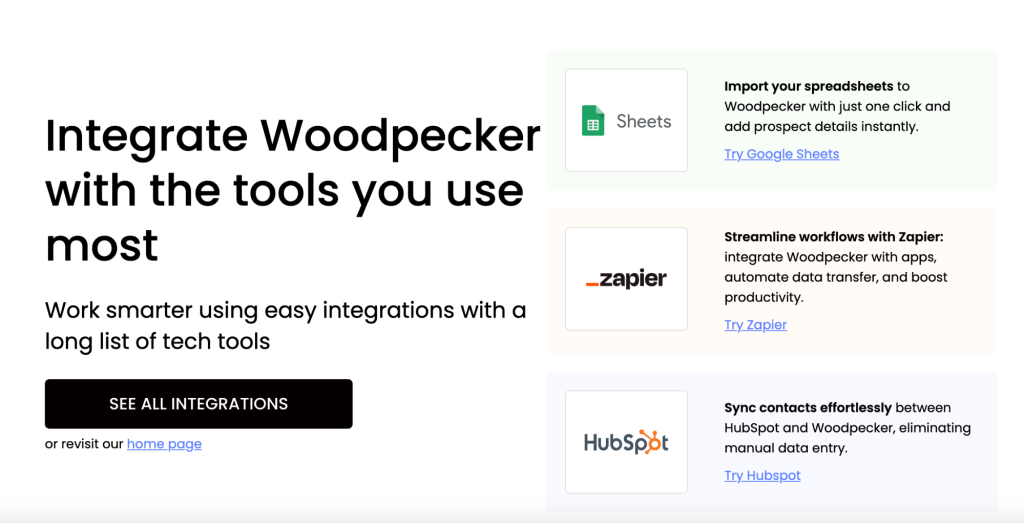
Woodpecker is your go-to for sending lots of personalized emails fast. It’s perfect for folks who want to up their outreach game but keep things feeling personal.
Key Features:
- Personalization: Drops in details like name and company into emails. Makes each one feel like it’s just for them.
- Integrations: Hooks up with your CRM and email, so everything runs smoothly.
- Checks emails: It looks at your list and kicks out the bad emails. This means fewer emails bounce back.
- Ready-made templates: Got templates you can tweak. Saves time and keeps your emails looking sharp.
- A/B testing: Test different emails to see what hits the mark.
- Smart follow-ups: Sends follow-ups based on how folks react. Keeps the convo going.
- Stays out of spam: Helps your emails get to the inbox, not lost in spam.
Woodpecker makes asking for backlinks a breeze. Its knack for personalizing emails means your requests don’t end up feeling like spam. The follow-up feature is a game-changer, making sure you stay on radar without nagging. And because it helps your emails dodge the spam folder, your chances of getting a “yes” for a backlink go way up.
Don’t Shy From Outreach Link Building
Outreach doesn’t have to be cumbersome. Tools like Woodpecker greatly improve this process. Proper strategies also aid in streamlining your outreach efforts. Here are the key takeaways from this article:
- Personalize your messages. Showing genuine interest enhances your likelihood of securing a backlink.
- Employ a variety of strategies. Combining methods like broken link building with digital PR can yield superior results.
- Stay committed. Consistent outreach and adaptation of your tactics are key to long-term success.
Ready to streamline your outreach process? Try Woodpecker, the cold email software designed to personalize and automate your email campaigns. Start using Woodpecker today to supercharge your link building strategy!
FAQ on backlink outreach
How to do email outreach for backlinks?
To effectively conduct email outreach for backlinks, personalize your emails, provide clear value, and be succinct. Start by researching potential link partners, crafting a compelling subject line, and outlining what benefits your content offers to them. Follow up respectfully if you don’t receive a response.
What are the three types of backlinks?
The three primary types of backlinks are:
- Do-follow: These provide SEO benefits and influence search engine results pages (SERPs).
- No-follow: These do not influence SERPs but can still generate traffic.
- UGC (User Generated Content) and Sponsored: These include links from comments or paid posts, respectively, marked specifically by rel attributes.
What is a backlink example?
An example of a backlink could be a website about baking linking to your own blog post about the best chocolate cake recipes. This link signals to search engines that your content is credible and relevant, potentially boosting your site’s visibility in search engine results pages.
What is an email outreach?
Email outreach is a process within outreach campaigns where you contact other site owners or influencers via email to promote your content, secure backlinks, or build professional relationships. Effective outreach often involves link building outreach and backlink outreach campaigns.
What is outreach in backlinks?
Outreach in backlinks, or outreach link building, involves contacting other website owners to request backlinks to your site. This tactic is used to enhance your site’s rating according to a website authority checker and rankings on search engine results pages by increasing the number of quality backlinks pointing to your site.

